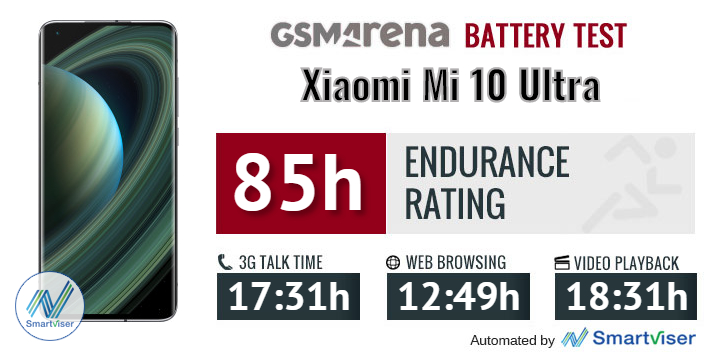Introduction
The Xiaomi Mi 10 Ultra - it is hands down the best phone you cannot buy so far. Celebrating Xiaomi's 10th anniversary, the Ultra pushes the limits of the Mi 10 series and brings the lineup to a close with the ultimate screen, the fastest charging, and the best of cameras.
The Mi 10 Ultra upgrades on the already great Mi 10 Pro with plenty display enhancements - the screen now supports true 10bit color and hence it can display 1 billion colors. It is also much brighter at 800 nits, but the most important upgrade is probably the 120Hz refresh rate.

The rear camera is truly impressive - it has everything you can think of, in the realm of current technology, that is. The main camera relies on a new OmniVision 48MP sensor with an OIS lens, then comes another 48MP snapper by Sony behind a 5x zoom lens. There is also a 12MP portrait shooter for 2x zoomed photos and a 20MP cam witha 12mm ultra-wide lens that is also suited for ultra-macro shots. One thing that is a first-ever is the option to capture 8K clips with the 5x imager. How about that?!
Another first is the 120W fast wired charging. The 120W brick in the retail box that will refill 40% of the battery in mere 5 minutes. Let that sink in! The Ultra also supports 50W fast wireless charging provided you buy Xiaomi's own 55W wireless charger that's sold separately.

Such a special edition can't be the same without some sort of unique wrapping and Xiaomi does offer one - in addition to the Obsidian Black and Mercury Silver versions, you can also opt for a limited Transparent Edition.
Unfortunately, the Ultra is currently slated for sales only in China and Xiaomi seems firm in its decision despite various requests across forums and even online petitions.
Xiaomi Mi 10 Ultra specs:
- Body: 162.4x75.1x9.5mm, 222g; curved Gorilla Glass front and back, aluminum frame; Obsidian Black, Mercury Silver, Transparent color schemes.
- Screen: 6.67" Super AMOLED, 1080x2340px resolution, 19.5:9 aspect ratio, 386ppi; 120Hz refresh rate; HDR10+ support, 800nits brightness, 1B colors.
- Chipset: Snapdragon 865 (7nm+): Octa-core CPU (1x2.84 GHz Kryo 585 & 3x2.42 GHz Kryo 585 & 4x1.8 GHz Kryo 585); Adreno 650 GPU.
- Memory: 8/12/16GB RAM, 128/256/512GB built-in UFS 3.1 storage.
- OS/Software: Android 10, MIUI 12.
- Rear camera: Wide (main): 48MP, 1/1.32" sensor, 1.2µmm pixel size, 25mm equiv. focal length, f/1.9 aperture, Laser AF, OIS. Telephoto: 12MP, 1/2.55", 1.4µmm, 50mm lens, f/2.0, Dual Pixel PDAF. Long-range telephoto: 48MP, 1/2.0", 0.8µmm, 120mm lens, f/4.1, Dual Pixel PDAF, OIS. Ultrawide angle: 20MP, 1/2.8", 1.0µmm, 12mm, f/2.2, PDAF, ultra-macro.
- Front camera: 20 MP, f/2.3, 0.8µmm, 1080p video.
- Video recording: Rear camera: 8K 4320p@24fps, 4K 2160p@30/60fps, FullHD 1080p@30/60/120/240/960fps; Front camera: FullHD 1080p@30fps.
- Battery: 4,500mAh, 120W fast charging support, USB-PD support, 50W wireless charging, 10W reverse wireless charging.
- Connectivity: 5G, Bluetooth 5.1, NFC, Wi-Fi a/b/g/n/ac/ax, dual GPS, USB-C
- Misc: Stereo speakers; Optical under-display fingerprint reader; IR port.
Ingress protection is what you won't be getting with the Mi 10 Ultra and it seems 10 years weren't enough for the maker to invest in such thing. Then again, Xiaomi did put money on a variety of startups and devices, that we just can't imagine a world without a Mi Band, Mi vacuums, Mi Air Purifier, Mi Routers, Mi Bulbs, and Mi whatnot. So, yes, we can live without the IP68 rating but it's really nice to have - if someone from Xiaomi is reading this.
Even though we won't be seeing the Mi 10 Ultra officially outside China, we are sure many will be getting this Chinese model one way or the other. And now we are going to find if it is worth the fuss and the hassle of getting a grey import. So, it's time we unbox this commemorative Mi 10 Ultra Transparent Edition!
Unboxing the Mi 10 Ultra
The Mi 10 Ultra is packed in a tall paper box and you may think you will get more contents than, say, the Mi 10 Pro bundle. Well, that's both true and false.
The box contains a charger, a USB-C cable, a 3.5mm adapter, and a transparent silicone case. You aren't getting any extra goodies.

Then again that heavy brick is the ultimate 120W charger - currently the fastest in the world. And the USB cable is rated at 6A - something you don't see every day and definitely - a cable that isn't a standard issue.

If you want to enhance your experience with the Ultra, you may also opt for the 55W wireless charger Xiaomi is selling separately.

There is also a special plastic case with carbon fiber pattern (again, sold separately), but hiding the Transparent edition's back with a case would be a real shame.
Design, build, handling
The Xiaomi Mi 10 Ultra looks and feels familiar, that is, if you have ever handled the Mi 10 or 10 Pro. It is a phone of the same curvy shape and a solid footprint. And unless you are among the few lucky ones to get the Transparent Edition (like us, we do brag, yes), the Ultra will also look like your typical glass-sandwich phone.

The Xiaomi Mi 10 Ultra is every bit as premium as you can expect - it has durable and curved Gorilla Glass pieces on both ends, a polished aluminum frame on the sides, one impressively thin camera setup, and a nearly bezel-less HDR HRR OLED screen with a small punch hole.
The lack of water protection is a disappointment, but Xiaomi has never had an IP68-rated phone for reasons unknown, so we can't say we were surprised of its omission on the Ultra. It is a long-overdue step, though, and we hope Xiaomi doesn't wait another ten years to take it.

Back to the Ultra, we want to start with the screen, which may be a 1080p one, but what a marvelous piece it is! The 6.67" AMOLED screen is of the same size and resolution as on the Mi 10 and 10 Pro, but the actual panel behind the curved Gorilla Glass 5 is different.
TLC is the manufacturer of the said screen, and it offers a lot over the other Mi 10 phones - 120Hz refresh rate (vs. 90Hz), can show up to 1 billion colors (vs. 16 million), and can be 800 nits bright when necessary (vs. 500nits). Then there is the sensor grid with 240Hz touch sampling rate.
 Mi 10 Ultra next to Mi 10 Pro (right)
Mi 10 Ultra next to Mi 10 Pro (right)
We are fans of this panel, as you can tell. Xiaomi did try its best with the new wallpapers and MIUI12 animations, and everything is just so smooth and sweet. The maker wanted the screen to awe people, and indeed it does that.
We are not the biggest fans of the curved screens because we often hold them wrong and trigger unwanted finger registers, but not on the Mi 10 Ultra. Frankly, the panel beneath the glass does not have an as steep curve as suggested by the glass, and that's probably what solved the thing for us.
The front of the Ultra has a couple more features deserving of attention. The most obvious one is the small punch-hole for the 20MP selfie snapper. It is quite tiny and it was not a distraction for when watching Netflix or similar.

Then there is the earpiece/speaker, which is invisible to the naked eye. It is within one razorblade-thin gap between the frame and the screen glass. The Ultra offers a stereo speaker setup, and the earpiece, as it is often done these days, acts as a speaker even if it is not as loud as the full-blown bottom piece.

Finally, there is an optical fingerprint reader behind the OLED screen, as usual - near the bottom. It is plenty fast and accurate, and we haven't had a single issue with it throughout the week we handled the Mi 10 Ultra.
Now, let us flip the Mi 10 Ultra. The back is made of Gorilla Glass 6, a curved single piece bent towards all four sides. You can have it painted in Obsidian Black or Mercury Silver. Or opt for the Transparent Edition - the one we have right here.

The transparent back is, well, indeed transparent, fading to black near the sides and thus hiding the internal pieces of the metal frame that holds everything together. But what you can see beneath the glass is not that interesting. The wireless charging coil, the NFC antenna, and a single screw. The rest is covered by a thin black layer, probably graphene for taking the heat off the battery.
The lack of interesting stuff to see is probably what made Xiaomi to mark the spots of everything important on the glass and you can see some mockups of the circuitry and the borders of the periscopic lens. There are some cool inscriptions here and there, too.
It is true the transparent panel looks cool, even cooler with the markup, but it is not really showing the chips or the battery. If you adjust your expectations, you will not be disappointed for sure.
 Xiaomi Mi 10 Ultra next to Galaxy Note20 Ultra (in bornze)
Xiaomi Mi 10 Ultra next to Galaxy Note20 Ultra (in bornze)
Of course, what's even more impressive is that this transparent piece of Gorilla Glass is the camera setup. It is huge, and yet it does not protrude as many of the competitors, which is some sort of achievement itself.
Top to bottom you are seeing the end of the periscopic lens over a 48MP sensor - this combo provides 5x optical zoom. Then follows another zoom camera, this time a 12MP shooter that is best for portraits as it does 2x optical zoom.

The third camera is the primary one, with an innovative 48MP OmniVision sensor, with a wide lens and optical stabilization. This one, and the 5x snapper support 8K video capturing.
Finally, the last one is the 20MP snapper with ultra-wide lens and autofocus, meaning in addition to those ultra-wide shots, it can also do ultra-macro.

Around these impressive snappers is a triple-LED dual-tone flash and the laser emitter and receiver that assist the autofocus.
Let's talk about the frame for a bit. It is very thin and slightly curved, with a glossy finish - ergo the lack of comfortable grip. The aluminum is very thin around the longer sides, meaning most of the left and right parts of the Mi 10 Ultra are basically made of glass. Xiaomi managed to fit the volume and power keys on the right, though, so that's good.

The top of the Mi 10 Ultra has the IR blaster and one mic, while the bottom is overcrowded with the dual-SIM tray, the mouthpiece, the USB-C port and the second speaker.

The Xiaomi Mi 10 Ultra is beautiful, and the transparent edition looks beyond cool. But it is not for everybody, but that's fine - the black or silver options are still some excellent choices.
No matter what option you get - revealing or concealing - the Mi 10 Ultra is of premium quality and build all around. Handling is far from ideal, as is the case with such beauties, and that's why you should consider using the bundled transparent case.
 Xiaomi Mi 10 Ultra next to Mi 10 Pro
Xiaomi Mi 10 Ultra next to Mi 10 Pro
If only the Ultra was water-proofed, too, but that is a wish not coming true today. We did find some rubber sealing around the SIM tray, so we'd throw this wild guess and say Xiaomi did make it splash-proof, it is just not advertising it - better survive some accidental splashes rather than die when deliberately splashed, we guess.
The display has everything
The 6.67" OLED screen is a real showstopper, and the Ultra has every right to brag with its TCL panel. It is with the same size, curves, and extended 1080p resolution as on the Mi 10 and Mi 10 Pro, but the similarities end here.

The Ultra's display supports 120Hz refresh rate, meaning it can show up to 120 frames per second. Everything looks super smooth, indeed. The 120Hz option works dynamically - it is always showing 120fps throughout the UI and all system apps, but it reverts to 60Hz when the picture is static. You can't see this switch unless you use an FPS counter, and that's good - the phone saves battery whenever possible and but you can't tell it.
The touch sensors are working with a super-sensitive 240Hz sampling rate, which should be appreciated by gamers mostly. The screen responsiveness is among the best you can get today.

There is support for HDR10 and HDR10+ so that you can enjoy HDR content from streaming and the likes. The phone supports Widevine L1 DRM - meaning will serve the highest streaming quality.
Another cool thing about the Mi 10 Ultra is the native support for 10bit color, meaning the screen can show 1.07 billion colors vs. 16 million on most other phones.
Finally, the Mi 10 Ultra display should be much brighter than the rest of the series. It promises 800 nits of brightness and 1120nits of peak brightness when watching HDR content.
We can attest the 800nits brightness, 811 nits to be exact - when the screen is set to Auto Brightness or when you turn the Sunlight Boost when in Manual Brightness Mode. The maximum brightness at the end of the brightness slider is 500 nits.
The promised peak brightness of 1120 nits is just that - peak brightness - with just a small part of the screen occupied by content - likely when you are playing back HDR video.
We can tell you the minimum brightness though - mere 1.2nits - a thoroughly impressive one.
| Display test | 100% brightness | ||
| Black, |
White, |
||
| 0 | 498 | ∞ | |
| 0 | 811 | ∞ | |
| 0 | 510 | ∞ | |
| 0 | 858 | ∞ | |
| 0 | 522 | ∞ | |
| 0 | 854 | ∞ | |
| 0 | 442 | ∞ | |
| 0 | 610 | ∞ | |
| 0 | 425 | ∞ | |
| 0 | 531 | ∞ | |
| 0 | 455 | ∞ | |
| 0 | 760 | ∞ | |
| 0 | 504 | ∞ | |
| 0 | 1024 | ∞ | |
| 0 | 398 | ∞ | |
| 0 | 894 | ∞ | |
| 0 | 820 | ∞ | |
| 0 | 333 | ∞ | |
| 0 | 538 | ∞ | |
| 0 | 538 | ∞ | |
| 0 | 888 | ∞ | |
| 0 | 525 | ∞ | |
| 0 | 635 | ∞ | |
Xiaomi offers three different Color presets - Auto, Original, Saturated - each one representing a specific color space.
The Auto option fully covers the DCI-P3 color space, but it also adjusts the colors to correspond to your current lighting (like Apple's True Tone). In normal daylight conditions in our office, we measured an average deltaE of 3.9. It can get a bit more or less absolutely accurate depending on the type of ambient light.
The Original setting corresponds to sRGB, and we also recorded an average deltaE of 1.2 for the color accuracy, meaning it is an excellent one.
Finally, the Saturated makes the colors pop, and they are no longer as accurate to DCI-P3.
There are also Advanced Settings, where you can specifically choose between DCI-P3, sRGB, Original (Auto Detects color gamut), or Enhanced. The last one shows everything in the widest possible color gamut.
Battery life and fast charging speeds
The Xiaomi Mi 10 Ultra is powered by a graphene-enhanced Li-Ion battery with a capacity of 4,500 mAh. The battery is split into two cells of 2,250 mAh connected in series, which is essential for the fast wired and wireless charging technologies the Ultra employs. More on that in a bit.
First, let's talk about battery endurance. The Ultra posted a good score of 85 hours in our suite of tests - it did a marvelous job when it comes to on-screen tests but was uninspiring when it comes to calls and standby performance.

Our battery tests were automated thanks to SmartViser, using its viSerDevice app. The endurance rating above denotes how long a single battery charge will last you if you use the Xiaomi Mi 10 Ultra for an hour each of telephony, web browsing, and video playback daily. We've established this usage pattern so that our battery results are comparable across devices in the most common day-to-day tasks. The battery testing procedure is described in detail in case you're interested in the nitty-gritty. You can check out our complete battery test table, where you can see how all of the smartphones we've tested will compare under your own typical use.
And now, back to the battery charging. The Mi 10 Ultra is the first phone to support the whooping 120W fast wired charging. It comes bundled with a 120W brick and a proper 6A-certified USB cable. Xiaomi promises this combo will recharge 41% in 5 mins and 100% in just 23 mins.
Well, that's the first thing we put to the test. The charger indeed replenishes 40% in just 5 mins, while it took 26 mins for a full charge. Very impressive!

This is 3 minutes longer than what Xiaomi promised, but we guess ambient temperature may have something to do with that as well. See, the Mi 10 Ultra gets very hot while charging. It is one of the hottest phones (while charging) we've handled in a while, and our room temperature wasn't exactly ideal - about 25C. Maybe if it were in a cooler room, it would have reached 100% even faster. Not that 26mins is not blazing fast for such a large battery!
The Mi 10 Ultra also supports 50W fast wireless charging. If you want to enjoy it, you need to purchase the new 55W Xiaomi wireless charger. The Wireless charger comes without a power adapter but you can use the 120W that comes with the phone.

Xiaomi promises the Mi 10 Ultra fully will recharge in full in 40 minutes on the wireless charger. That's half the time the P40 Pro+ recharges its 4,200 mAh battery with the 40W SuperCharge Wireless Charging Stand.
We put that to the test as well. It takes exactly 41 minutes for the Ultra to go from 1% to 100%!
There is a catch though. If the battery is completely dead, it will take an extra 6 minutes for the phone to wake up, and it is only then that the Mi 10 Ultra actually starts charging fast on this wireless charger. Until the Ultra boots MIUI 12, it is slowly charging at 5W.
Stereo speakers
The Xiaomi Mi 10 Ultra has a hybrid stereo speaker setup - the earpiece acts as one, and another one at the bottom of the phone.
The Xiaomi Mi 10 Ultra offers Very Good loudness. The earpiece provides mostly mid-tones and is a bit quieter when compared to the bottom speaker. But the two pieces are tuned just right and work great together, providing a good balance.
Use the Playback controls to listen to the phone sample recordings (best use headphones). We measure the average loudness of the speakers in LUFS. A lower absolute value means a louder sound. A look at the frequency response chart will tell you how far off the ideal "0db" flat line is the reproduction of the bass, treble, and mid frequencies. You can add more phones to compare how they differ. The scores and ratings are not comparable with our older loudspeaker test. Learn more about how we test here.
MIUI 12 on top of Android 10
The Xiaomi Mi 10 Ultra is the first smartphone we meet that boots MIUI 12 out of the box. The new launcher is based on Android 10 and introduces a refined interface with new animations, new privacy options, floating windows, dedicated Control Center, Super Wallpapers, and a brand-new app drawer, among other features.

The new MIUI 12 is not a massive overhaul over MIUI 11, but more of a refresh with new looks here and there, new cooler animations optimized for high-refresh-rate screens, and a couple of new features though it's up to you whether you'll use them or not.
One of the most striking visual changes is the addition of Super Wallpapers. Long story short - this is a dynamic wallpaper that zooms each time you pass a certain screen. You start small on the Always-on screen (you see the planet Mars), then you wake up the Ultra, and the phone zooms in on Mars, and finally, when you reach the homescreen, the Ultra zooms in further revealing one very cool Mars canyon. You can choose between a few locations for the final zoom level). Moving between homescreen rotates around the said canyon, or crater, or hills.
The Super Wallpapers are not something unseen, but they provide one very coherent visual experience that is a feast for the eyes and in the meantime - connects the parts of MIUI in a subtle yet striking way.
There are three Super Wallpapers available at launch - Home (Earth), The Red Planet (Mars), and faraway Rings (rings of Saturn).
The Ultra supports Always-on display, and you can schedule it or leave it on/off all the time. MIUI 12 brings a ton of new AOD themes you can choose from and make it yours. You can customize many of those. The Always-on display also supports breathing light - the curved edges of the display will flash with colors upon new notifications.
You unlock the screen via the blazing-fast optical under-display fingerprint scanner. The reader is easy to set up, fast, and superbly accurate - it is on par with the best in business. 2D Face Unlock is available, too, but it is far less secure than the fingerprint option.
The homescreens are business as usual - they are populated with shortcuts, folders, and widgets. The leftmost pane, if enabled, is called App Vault and while with a bit refreshed looks, it is still the same as before - shows cards and shortcuts from the chosen apps (calendar, weather, news, favorites, etc.).
MIUI 12 offers an app drawer by default, and it automatically organizes your apps into categories. The first is All, meaning it contains all apps. Then follow Communication, Entertainment, Photography, Tools, New, and Business. You can edit these categories or even disable them altogether. You can disable the app drawer entirely if that's not your thing.
Another new feature is the Notification shade split into Notification Center and Control Center. Indeed, this is precisely what the iPhones do, and you even summon them in the same fashion - pull down from the left part of the screen for the Notification Center, pull down from the right for the Control Center.

If you are not fond of this new split - you can disable the Control Center, and the shade will revert to its MIUI 11 looks and operation.





Notification Center • Notification Center • Control Center • Control Center • The old Notification Shade
The task switcher has not changed much. It shows all of your recent apps in two columns. Tap and hold on a card for the split-screen shortcut, or just swipe it left or right to close it. There is a new Floating Windows button on top, which is a new option offered by MIUI 12. You can put any app in a floating state, but you only have one floating window at a time.



Task Switcher • Floating Windows • Floating app
Themes are a huge part of MIUI, and they are available on MIUI 12, too. You can download new ones from the Themes store, and they can change wallpapers, ringtones, system icons, system fonts, and even the always-on display style.
Xiaomi enhanced MIUI 12 with a couple of additional privacy options. Now when sharing stuff, like photos and videos, you can opt to remove location and/or other metadata (incl. device info) and thus protect your privacy fully. Neat.
MIUI also offers a Security app. It can scan your phone for malware, manage your blacklist, manage or restrict your data usage, configure battery behavior, and free up some RAM. It can also manage the permissions of your installed apps and allows you to define the battery behavior of selected apps and applies restrictions only to the apps you choose.
MIUI 12 packs proprietary Gallery, Music, and Video player. In some regions, the music and video apps include paid streaming options. Mi Remote for the IR blaster is available, too. In China, a new Mi AI assistant is part of MIUI 12, replacing the Google Assistant.
MIUI 12 also enhances the Notes app with even more Task checklists and subtask options.





Security • Security • Music • Video • Mi Remote
MIUI 12 supports Dark Mode, too, and you can even force it on wallpapers or restrict its application on incompatible individual apps.
MIUI 12 is fully optimized to work on HRR displays, and we have to say - it looks gorgeous on the Ultra. Everything is smooth and fast; animations are unobtrusive yet impressive, the attention to the detail is simply excellent. We did enjoy working with this new MIUI on the Ultra's 120Hz for sure.
Finally, the Mi 10 Ultra is currently sold only in China, and because of that, it lacks Google Play Store and Services out of the box. It is a Google-certified phone, so it is very easy to get both installed. Just search Settings for Play Services and enable them. Then go to the Mi Store and install Play Store. Simple as that.
Performance and benchmarks
Just like the Mi 10 and Mi 10 Pro, the Xiaomi Mi 10 Ultra runs on the Qualcomm's Snapdragon 865 chip. It features Qualcomm's X55 modem that adds full-fledged 5G connectivity.
The Snapdragon 865 has an octa-core processor with a familiar core configuration - 1x2.84 GHz Kryo 585 Gold (Cortex-A77 derivative) & 3x2.42 GHz Kryo 585 Gold (Cortex-A77 derivative) & 4x1.8 GHz Kryo 585 Silver (Cortex-A55 derivative).
The Adreno 650 is part of the Snapdragon 865 and it a might GPU, among the best in the business.
The Snapdragon 865 chip supports LPDDR5 RAM, and the Mi 10 Ultra is available with 8GB, 12GB (ours) or even 16GB LPDDR5 RAM. The storage options are 128GB, 256GB, and 512GB, and the storage is of the UFS 3.1 kind.

We ran the usual benchmarks and, unsurprisingly, the Mi 10 Ultra aces all of them.
It packs the best processor Android has to offer. The Snapdragon 865+ inside the ROG3 has its Prime core clocked a bit higher (3.1GHz vs. 2.84GHz) and thus the small difference in single-core computing.
GeekBench 5.1 (multi-core)
Higher is better
- OnePlus 8
3399 - OnePlus 8 Pro (120Hz, 1440p)
3374 - Asus ROG Phone 3 (144Hz)
3357 - Xiaomi Mi 10 Pro 5G
3331 - Xiaomi Mi 10 Ultra
3248 - Huawei P40 Pro+
3203 - Huawei P40 Pro
3197 - Realme X50 Pro
3175 - Galaxy S20 Ultra 5G (120Hz, 1080p)
2697 - Samsung Galaxy Note20 Ultra 5G
2603 - vivo X50 Pro
1937
GeekBench 5.1 (single-core)
Higher is better
- Asus ROG Phone 3 (144Hz)
975 - OnePlus 8
919 - Realme X50 Pro
911 - Xiaomi Mi 10 Pro 5G
905 - Galaxy S20 Ultra 5G (120Hz, 1080p)
904 - OnePlus 8 Pro (120Hz, 1440p)
902 - Xiaomi Mi 10 Ultra
901 - Samsung Galaxy Note20 Ultra 5G
880 - Huawei P40 Pro+
781 - Huawei P40 Pro
780 - vivo X50 Pro
636
The graphic scores are chart-topping as expected.
GFX 3.1 Manhattan (onscreen)
Higher is better
- Asus ROG Phone 3 (144Hz)
82 - Xiaomi Mi 10 Ultra
78 - Samsung Galaxy Note20 Ultra 5G
76 - Xiaomi Mi 10 Pro 5G
75 - Galaxy S20 Ultra 5G (120Hz, 1080p)
74 - Realme X50 Pro
60 - Huawei P40 Pro
52 - Huawei P40 Pro+
52 - OnePlus 8 Pro (120Hz, 1440p)
43 - vivo X50 Pro
31
GFX 3.1 Car scene (onscreen)
Higher is better
- Asus ROG Phone 3 (144Hz)
48 - Xiaomi Mi 10 Ultra
46 - OnePlus 8
46 - Realme X50 Pro
45 - Galaxy S20 Ultra 5G (120Hz, 1080p)
43 - Xiaomi Mi 10 Pro 5G
42 - Samsung Galaxy Note20 Ultra 5G
42 - Huawei P40 Pro
31 - Huawei P40 Pro+
31 - OnePlus 8 Pro (120Hz, 1440p)
24 - vivo X50 Pro
17
3DMark SSE Vulkan 1440p
Higher is better
- OnePlus 8
6720 - Realme X50 Pro
6472 - Xiaomi Mi 10 Ultra
6431 - OnePlus 8 Pro (120Hz, 1440p)
6425 - Galaxy S20 Ultra 5G (120Hz, 1080p)
6308 - Samsung Galaxy Note20 Ultra 5G
6248 - Huawei P40 Pro+
5641 - Huawei P40 Pro
5637 - vivo X50 Pro
2983
Finally, the Mi 10 Ultra topped our all-time AnTuTu 8 chart, for now at least.
AnTuTu 8
Higher is better
- Xiaomi Mi 10 Ultra
638497 - Asus ROG Phone 3 (144Hz)
601858 - Xiaomi Mi 10 Pro 5G
595246 - Realme X50 Pro
592447 - OnePlus 8 Pro (120Hz, 1440p)
573276 - OnePlus 8
564708 - Huawei P40 Pro+
529687 - Galaxy S20 Ultra 5G (120Hz, 1080p)
514485 - Samsung Galaxy Note20 Ultra 5G
508760 - Huawei P40 Pro
496356 - vivo X50 Pro
323736
The Xiaomi Mi 10 Ultra has one of the best hardware platforms as of the time of writing, and the benchmarks are an easy tell of its capabilities. Its 8-core CPU is blazing-fast, while its GPU is ready to take the heaviest of games and show them in more than 60fps where possible.
The phone gets a bit warm after prolonged benchmark and gaming sessions, but we didn't notice a noticeable drop in the performance or unpleasant feeling (as the one we got when the Ultra was hooked on the 120W charger).
So, the Mi 10 Ultra is one of the fastest phones on the market, and it will offer one of the best experiences possible right now.
One of the best quad-camera setups on the market
On the back of the Mi 10 Ultra you will find a quad-camera setup with an ultra-wide, wide (primary), 2x tele, and 5x telephoto snappers. The camera system is similar to the Mi 10 Pro's, it just uses better image sensors and supposedly - lenses of higher quality. For selfies, you once again rely on a single front camera.

Let's go through some technical bits now.
The main camera is based around a new 48MP OV48C 1/1.32" sensor by OmniVision. It has 1.2µm pixels and a Quad Bayer color filter, which means it is going to output 12MP images by default. The sensor is paired with an 8-element lens that is stabilized and has an f/1.85 aperture. It covers an 82-degree field-of-view, which in our world equates to a 25mm in 35mm equivalent.
This new OV48C sensor can do on-chip single-frame HDR processing. Basically, pixels are grouped into three categories: short, medium and long exposure. Then those are merged into an HDR signal as the sensor reads out the image line by line.
Another thing this camera is capable of doing - 8K videos capturing at 24fps.
Next up is the telephoto camera - the first of two. It is identical to the one on the Mi 10 Pro - a 12MP Samsung ISOCELL Fast S5K2L7 1/2.55"sensor with 1.4µm pixels, dual-pixel autofocus, and bright f/2.0 50mm lens - pretty nice specs for a zoom camera. There is no OIS, but Dual Pixel PDAF is available.
The second telephoto camera is something Xiaomi is proud of making as it pushes the envelope of what periscope-based cameras are capable of. This one is the first to offer a high-res large sensor, the first one with 8K video capture, and also allegedly, the first one to use a D-cut lens.
So, the long-range camera employs a Sony IMX586 1/2.32"-type sensor with 0.8µm pixels and f/4.1 120mm lens. Both OIS and Dual Pixel PDAF are available for this shooter. The sensor was too large for the periscope and it would have made it too thick to fit into the frame of the phone. That's why Xiaomi had to use a D-cut lens to slim it down. D-cut lenses make optical image stabilization more difficult, however, so it took several iterations until the engineers got it just right.
Finally, the Mi 10 Ultra has the same 20MP camera for ultra-wide shots as the Mi 10 Pro. It uses Sony IMX350 1/2.78" sensor with 1.0µm pixels behind 12mm f/2.2 lens. PDAF is available, unlike the bulk of the ultrawides out there. This means it can also do closeup photos and videos.
The ultrawide-angle lens has a 128° field of view. It uses a 7P lens again to minimize distortion, especially around the edges of the image (it also minimizes vignetting).

Over on the front, the Mi 10 Ultra has a 20MP camera for selfies, same as on the Mi 10 Pro - it uses Samsung's ISOCELL Slim S5K3T2 1/3.4" sensor with 0.8µm pixels and Quad-Bayer color filter. It still spits images at the nominal 20MP resolution, so you should not expect great levels of detail. Xiaomi specifies an f/2.3 aperture but omits the focal length. Autofocus isn't available for selfies.
Camera app
The camera app is a rather straightforward implementation. You swipe from side to side to change modes, and you can also tap on the ones that you can see to switch to those directly, though they don't all show up in one screen. Up and down swipes don't work for switching between the front and rear cameras, only the toggle next to the shutter release does that.

On the near end, you have the camera zoom switch that operates in one of two fashions. The first one is simply tapping on one of the three dots that represent the ultra-wide, primary, and 5x zoom snappers.
Or you can tap on the active magnification and reveal even more zoom modes - 2x, 10, and 120x, while still leaving out the macro mode. It seems Xiaomi wanted to use the 2x snapper for portraits only and left it out of the viewfinder - something we wholeheartedly disagree with and find it way inconvenient to tap the dot to reveal more dots in order to get to the 2x telephoto. It was a big issues for us.
On the opposite end of the viewfinder, you have a flash mode switch, an HDR switch, an AI toggle, Live Photo enabler and a magic wand with beauty effects and filters. Behind a hamburger menu, you'll find some more options including the Macro mode, plus the shortcut to the settings. What you won't find is an option to set the output resolution for any of the cameras.
There's a nicely capable Pro mode, where you can tweak the shooting parameters yourself. You get to pick one of 4 white balance presets or dial in the light temperature with a slider, there's a manual focusing slider (arbitrary units 0-100), and shutter speed and ISO control with ranges depending on which camera you're using. That's right, best of all, you can access each of the five cams in Pro mode. There's also a focus peaking toggle up top, as well as a metering mode selector. All four cameras support a maximum shutter speed of 30 seconds.
Night Mode is available, too, but it works only on the primary and ultrawide cameras.
Photo quality assessment
Let's start with daylight samples, as usual. The ones coming from the primary camera of the Mi 10 Ultra are saved in 12MP, though it is possible to opt for 48MP output, too.

The photos we snapped with the Ultra's main camera are simply outstanding. The resolved detail is plenty, the contrast - superb, while the white balance and the color reproduction are spot-on - among the most accurate we've seen in a while.
The dynamic range is rather impressive, too, but we expected nothing less as the on-chip HDR processing sounded quite promising on paper.
Some of the photos could have looked a notch better if they were a tad less sharp, but this is nitpicking, really.
A dedicated 48MP is available, but we cannot recommend it. The photos are upscaled versions of the 12MP default images and when downscaled to 12MP - you will find them identical with the default sources.
The 20MP shots from the ultrawide camera do fit a lot in the frame - this is among the snappers with the widest field of view we've encountered lately. The photos are detailed enough, with excellent white balance, colors, and contrast. The dynamic range is quite good, too.
There is significant geometric distortion in the samples below despite the automatic distortion correction. Still, this must be one of the wides ultra-wide cameras on a phone so that's probably expected.
The Mi 10 Ultra has a dedicated Macro mode, which uses the ultrawide camera for the closeups. Unfortunately, the photos aren't that good - they lack in detail and often lack a proper focus. They are nowhere near what you can achieve with a crop from the main camera.
Let's move to the tele shooters now. We start with the regular telephoto that offers 2x optical zoom over the main camera. This one also snaps 12MP pictures, and they are flagship-grade - the resolved detail is great, the sharpness is just right, the colors are matched to the main camera, and the dynamic range is once again high.
This is also the (only rear) camera that shoots portraits and those are perfect - the subject separation is stunning, and the blur is very natural looking. The samples are quite detailed, though the sharpness deteriorates rapidly as light becomes less than ideal.






2x telephoto camera, portraits, 12MP
And now let's look at some 5x zoomed photos shot from the second, long-range telephoto - the 48MP one. Quite expectedly, the photos are saved in 12MP resolution, and this time around, there is no trickery to achieve the 5x zoom. Unlike the Mi 10 Pro, the Ultra does come with a lens with the proper focal length (120-127mm depending on your source) and thus provides real 5x optical zoom over the main camera (24-25mm, again depending on the source of info).
The photos with took with this camera are brilliant. The detail is abundant, colors and white balance are once again very accurate, the dynamic range is pretty good, and the noise is kept impressively low.
Overall, these are probably the best 5x zoomed shots we've seen to date.
Just like with the main camera, you can also shoot in 48MP with this long-range telephoto. And once again - the images are looking as upscaled versions of the default 12MP ones, and you will not get more detail if you shoot in 48MP and then downscale to 12MP.
With these, our first round of photos samples is done. Come nightfall, and we were out to do a second one, and the images we snapped are quite intriguing.
The 12MP night photos from the main camera look flawless. The snapper captures even the slightest traces of light, and the photos are plenty bright even without Night Mode, with balanced exposure, preserved and true-to-life colors and saturation, outstanding contrast, and impressively low noise.
Looking through these photos we can't even imagine why we would ever need the Night Mode. You can even see stars on some of these photos.
What we can, well, complain of, is that some of these snaps are a lot brighter than the scenes were in reality. Normally - making the night a day is a job for the called Night mode (isn't that some irony) - but the Ultra's regular mode is brighter than many competitors' dedicated Night Modes. This processing may not be everyone's cup of tea, just saying.
Then what does the Night Mode really do? Well, it restores blown highlights (look at the buildings' windows) and reveals more detail in some shadowy areas. It's a good thing it doesn't attempt to brighten the photo exposure even further.
The ultrawide low-light photos are quite noisy and even blurry at times, so there is no point of using this camera past sunset. The images are brighter than we expected, yes, and even retain good colors, but the noise and smudged spots still ruin them.
If you want to shoot with the ultrawide camera at night, then you should do it using the Night Mode. It does get rid of the noise and brings back a ton of detail, and of course - it also acts as HDR - restores highlights and reveals more detail in shadows.
The images are far from sharp, but very much usable.










Ultrawide camera, Night Mode, 20MP
The Mi 10 Ultra uses both of the telephoto shooters at night, unlike many other phones, though Night Mode is not available on either of them.
The 12MP pictures we took with the 2x shooter are quite nice - the detail is enough, they retain good colors, and in fact, do represent how the scenes really looked at nighttime. There is quite some noise that's untouched by the noise reduction processing - it is not that big of an issue, but it is the one thing Xiaomi can tweak via a software update.
The 12MP 5x zoomed photos coming from the long-range tele camera are impressive. Given the f/4.1 aperture and the lack of light in almost all of the scenes, the photos turned out to be excellent - there is a lot of detail captured, even in areas of high complexity, the colors are nice, contrast is very good. You cannot just see what's there - you can brag with that shot among your friends.
There is visible noise that's left by the processing and it can be tweak via an update, but even if left as is - the photos are exemplary.
The Pro (manual) mode works with all four cameras. We played a bit with the Pro mode on the 5x camera at this absurdly challenging to shoot scenes. Here is what we got.



5x telephoto, Manual mode, 12MP
Supermoon mode is present, and by default, it shoots Earth's natural satellite at 10x zoom. The first two photos are shot at about 10x, and they are pretty impressive. The third one is shot at 40x.
You can also add some cool textures to the zoomed Moon - like birds, trees, climbers, among others. They are shot at about 40x or 50x zoom so they are pretty pixelated, but they look sweet on Instagram.
And here are a couple of Long Exposure samples - Neon trails and Stary Sky.
Once you're done with the real world samples, head over to our Photo compare tool to see how the Mi 10 Ultra stacks up against other phones.



Mi 10 Ultra against the Galaxy Note20 Ultra and the Huawei P40 Pro in our Photo compare tool
Selfies
The 20MP selfies cannot be sharp because of the Quad-Bayer sensor. They still turned out nice though - the HDR works great when needed, and the images have good colors and contrast. We would have been just fine with the processed 5MP stills, too.
The selfie portraits show good enough though not flawless subject isolation, while the background blur is convincing.
Video quality assessment
The Xiaomi Mi 10 Ultra has a ton of video recording options. One of the key video features is the option to capture 8K videos at 24fps with its primary and 5x telephoto shooters. All other popular modes area available 4K at 30 and 60fps, as well as 1080 at 30 and 60 fps.

The main camera can do 30fps and 60fps capture in both 4K and 1080p resolutions.
The ultrawide camera supports 4K@30fps and 1080p at both 30fps and 60fps.
The 2x telephoto is unavailable for video capturing. You can do 2x capture on any resolution, but it is 2x digital zoom over the main camera. It's not bad, it's still digital, though.
The 5x telephoto can do 4K and 1080p at 30fps. It seems you can to 60fps, too, but this will be 5x digital zoom over the main camera.
Optical stabilization is available on the main and 5x tele snappers, while (optional) electronic stabilization is available on all snappers in all modes.
Before we dig into the video side of things, the audio in all of the videos is captured at 320Kbps. It's stereo, too.
And now it's time to go through some video footage.
Main camera
The 4K videos and 1080p at 30fps are among the best we've seen - the captured detail is astonishing, the white balance and colors are once again spot on, and we also get to enjoy excellent contrast and very good dynamic range.
The excellence continues over the 4K, and 1080p clips shot at 60fps - we did notice a small decrease in the dynamic range and a slight shift towards a bit warmer saturation, but we had to look hard to notice these things.
What about low-light performance? The 4K videos turned out to be good with more than enough detail, low noise, and preserved colors. The 1080p clips, on the other hand, look phenomenal!
This camera also offers 8K video capturing at a steady 24fps frame rate and those are shot at 100+Mbps bitrate - meaning you are looking at 700MB for every minute of footage. And it simply is not worth it. Looking at a 100% crop from the 8K video, it just looks like an upscaled image from 4K to 8K, which is more or less the case.
Ultrawide camera
The Mi 10 Ultra does a great job when shooting with its ultrawide camera. It can do 4K at 30fps and 1080p at both 30fps and 60fps. The clips are always nicely detailed, with very good color presentation and contrast.
The 4K clips are captured with 50Mbps bitrate, while in 1080p, the bit rates are 10Mbps for the 30fps and 20Mbps for the 60fps.
Telephoto 5x camera
Finally, the 4K and 1080p videos from the 5x shooter are magnificent. Just like on the main camera, here the resolved detail is exceptional, the color reproduction is great, the dynamic range is amazing. Overall, these are the best 5x zoomed videos any smartphone can offer right now.
You can also shoot with this camera at night, and if it isn't a pitch dark scene, the footage is more than usable.
You can do 8K clips at 24fps with this snapper, too, a first for the class. It looks like upscaled from 4K though, just like the main shooter's 8K videos, and we don't recommend using the 8K mode.
Stabilization
Electronic stabilization is available for all snappers in all resolutions and frame rates.
Here's a glimpse of how the Mi 10 Ultra compares to rivals in our Video compare tool. Just look at those detailed crops!



2160p: Mi 10 Ultra against the Galaxy Note20 Ultra and the Huawei P40 Pro in our Video compare tool
Wrap up
The Xiaomi Mi 10 Ultra turned out to be one of the best smartphones money can buy. Only if you live in China that is. And unless you are okay with shady imports, customs clearance, the lack of warranty, and the Chinese-infested firmware, you can't have it in any other part of the world. And that's a real pity!

The Mi 10 Ultra is truly one of the most intriguing smartphones of the season, if not the year. Its 120Hz AMOLED screen is buttery-smooth, very colorful, and quite bright. The Ultra also has the fastest chip to make whatever you are running perform at its best.
Then there is the large 4,500 mAh battery that can be recharged from flat to 50% in 8 mins with the 120W charger. Alternatively, you can use the 50W wireless charger and a full charge there will still take less than most of the competition's wired fast charging.
But what really impressed us was the rear camera setup. The main snapper is among the most distinguished photo and video shooters we have seen. And then the 5x telephoto is not that far behind either and offers the highest photo and video quality among its 5x peers.
The Mi 10 Ultra was built to impress, and it succeeds in being the Ultimate smartphone.
Alternatives
Since this phone is hard to get, however, the first alternative that comes to mind would be the Mi 10 Pro. It has a 90Hz screen (instead of 120Hz), its 5x telephoto isn't really 5x, and the battery charges at 30W, but it is still among the better flagships out there, and MIUI 12 will make it even better.
 Mi 10 Ultra and Pro
Mi 10 Ultra and Pro
Huawei P40 Pro+ is another phone worth considering, water-proofed at that. It has a great 90Hz OLED, an equally impressive camera package, and tops the Ultra with 10x optical zoom and selfie autofocus. It can recharge quite fast, too, and the lack of Google services isn't that big of an issue in China, while many other Huawei owners already found out that living without Google isn't that terrible after all.
 Mi 10 Ultra and Galaxy Note20 Ultra
Mi 10 Ultra and Galaxy Note20 Ultra
Samsung Galaxy Note20 Ultra is also water-protected, and it beats the Mi 10 Ultra with a larger screen, the S-Pen, and a better selfie camera. Its main camera setup is close to Mi 10's though still less impressive. But the Note is one of the widest available phones, so there is that.



Xiaomi Mi 10 Pro 5G • Huawei P40 Pro+ • Samsung Galaxy Note20 Ultra 5G
The vivo X50 Pro+ and Oppo Find X2 Pro are some excellent alternatives. Both impress with 120Hz OLEDs, Snapdragon 865 chips, and rear camera configurations that feature a periscope 5x snapper. Neither of them will match Ultra's quality across all four snappers, but they are still viable alternatives for those that don't put camera quality first.


vivo X50 Pro+ • Oppo Find X2 Pro
The verdict
There it is - the lucrative Mi 10 Ultra that only Chinese folks can have. We are sure many of you will be happy with a gray import. For the true Mi fans the hassle with customs and Google installations will be totally worth it.

But we also noticed that even regular users that are not hardcore Mi fans are ready to go the extra mile and risk with international deliveries to get this Mi 10 Ultra commemorative edition. And that says a lot.
Is it the best phone? Of course, not. It is not best, neither perfect. But it is really close to being both, and that alone is worth seeing and experiencing. We see why people want to get it.
Pros
- Outstanding 120Hz AMOLED screen, very bright, HDR10+
- The transparent glass build does look nice and unique
- 120W fast charging does 40% in 5 mins, 100% in 26 mins!
- 50W fast wireless charging, 100% in 40 mins!
- One of the fastest phones around, has 5G
- Superb day- and low-light photo on the main and zoom cameras
- Superb day- and low-light video on the main and zoom cameras
- One of the widest ultrawide cameras around
- One of the best portraits we've seen with the 2x camera
- Lovely and snappy MIUI 12
Cons
- No water protection, 3.5mm jack or microSD slot
- Uninspiring battery life
- Can't shoot videos with the 2x camera, mediocre selfies
- China-only
























































































































































































0 Response to "Xiaomi Mi 10 Ultra review"
Post a Comment